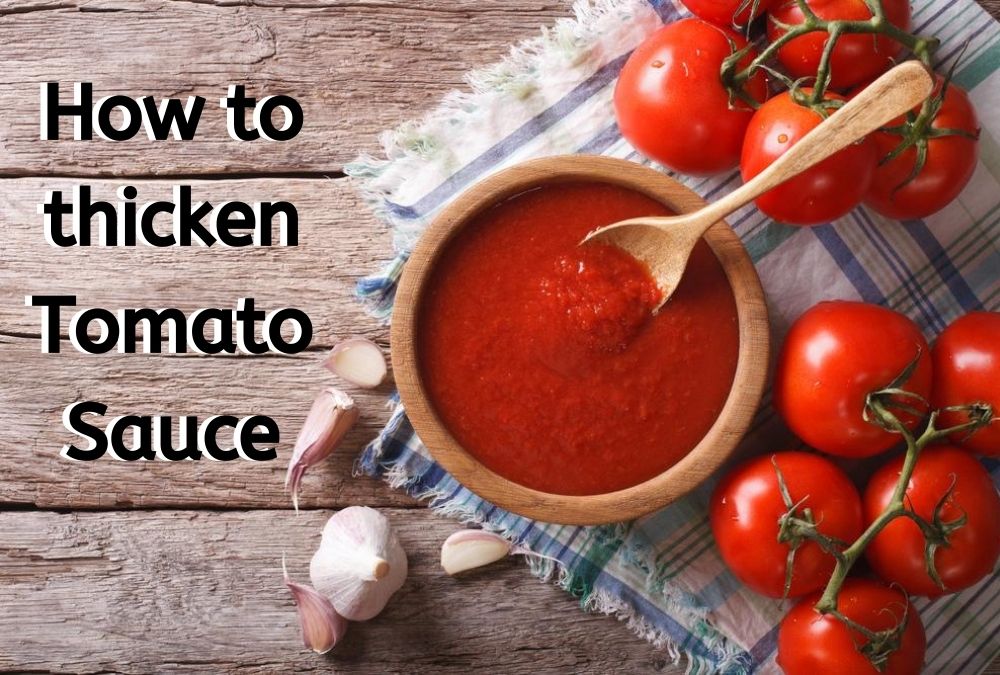Tomato sauce is a versatile staple in kitchens worldwide. It forms the base for various dishes, from pasta and pizzas to hearty stews and soups. But achieving the perfect consistency can sometimes be a challenge. A sauce that’s too thin can make your dish soggy and dilute its flavor, while a sauce that’s too thick can overwhelm your meal. This is why learning how to thicken tomato sauce is an essential skill for any home cook.
Tomatoes have an intense flavor, great water content, and soft flesh, which cooks down easily and is the right ingredient to determine how to thicken Tomato Sauce when they are cooked. All of these qualities make them perfect for simple and tempting sauces.
You cut liquid or add thickener like starch. These two methods cover every thickening technique which comes to mind. At the start, reduce the liquid by only adding less. To begin with, later boil off the liquid over time or add thicker liquid-like milk instead of water. Different Starches, namely flour, cornstarch, pasta water, breadcrumbs, and some even use mashed potatoes.
The reduction in liquid and addition of thickener are consecutive actions. You want to boil any added starches a little bit to reduce their starchy flavors. It Is easy to dissolve powders in a hot liquid, and in doing so, you will boil off a little liquid as you add in your starch. We will teach you how to thicken Tomato Sauce in all sorts of easy methods.
How to thicken Tomato Sauce
If you’re interested to know how to thicken tomato sauce, here, you will get it via EIGHT different but easy modes.
How to thicken tomato sauce with Reserve Pasta Water
Single Step: Set aside pasta water so you can use it for the sauce. The water in which you have cooked pasta has lots of starches floating, which makes it a powerful thickening agent! You don’t necessarily want to add it to the sauce, which is already too thin. Instead, use a bit of pasta water as the water you use in the recipe. Thus, learn how to thicken tomato sauce by this huts a
How to thicken tomato sauce by Adding Cornstarch
Step One: Cornstarch is pretty neutral in flavor and easy to add to the sauce that has already been made. You don’t need to mix it with anything or make a roux.
Step Two: Instead, stir in a small amount of cornstarch and let it cook for a minute or two, and you will often see results with a shockingly small amount of cornstarch.
How to thicken tomato sauce by Preparing a Roux
Single Step One: A roux is a combination of fat that has been cooked for a little bit and flour. While it takes some effort to mix flour and butter and cook them until it stops, making a roux is probably one of the most common ways an experienced chef will thicken pizza sauce. You can do that very quickly with a bit of practice. This is a somewhat tricky but satisfying way to learn how to thicken tomato sauce.
Method Four: Addition of Mashed Potatoes
Single Step One: This one sounds a bit crazy, but trust me – it works perfectly! Just like four cornstarch and pasta, potatoes are loaded with starch. If you have got a cooked potato lying around, try mashing it and blending it into your sauce. You will get a bit of unique flavor, and you will thicken your sauce up quite a bit.
Method Five: Thicken Up and Reduce Sauce Liquid
Step One: Regardless of what other techniques you use to thicken spaghetti sauce, you’ll probably want to use this one. If you let your sauce simmer over low heat for several minutes, that will cause lots of water to evaporate through the boiling process.
Step Two: You will also help blend the spices and herbs in the sauce, activate any starches you have added and cook off any starchy flavors. You don’t have to go crazy with cook times, as 20 minutes is usually plenty.
A simple trick that quickens the reduction process.
There is another simple and smart trick to determine how to thicken tomato sauce.
Instead of turning the heat up and waiting a long time for your sauce to reduce, use a wider pot or a pan. As the surface area increases, the time required for the sauce to loose liquid and thicken becomes less when you leave it to simmer.
Ideally, use a larger sauté pan, stockpot, or even a pan. When you increase the surface area of the sauce, the time required to reduce will go down.
Method Six: Swirl in a pat of butter
Single Step One: This method won’t add a serious amount of thickness, but it will give you an extra boost if you’re close but not quite there. Just make sure to swirl the butter into your sauce at the very end of the cooking process. The butter-infused sauce will break if it’s exposed to high heat, defeating the purpose of its thickening power.
Method Seven: Add an egg yolk
Single Step One: Egg yolks are a classic way to thicken salad dressings and custards, but they also work wonders for thickening rich cream sauces. To prevent the egg from scrambling, place the egg yolk in a bowl and slowly whisk in about a cup of the hot sauce. Then, add the tempered yolk mixture to the pot, whisking as you go. The egg yolk method also works well as a way to save a broken sauce.
Method Eight: Puree some vegetables
Step One: Starchy vegetables—like potatoes, winter squash, or celeriac—are excellent thickening agents, especially if they’ve been pureed. Simply roast or boil these vegetables and pop them into the food processor until smooth. Then, stir it into the sauce; it will instantly be thicker! You could also use steamed and mashed cauliflower, or any cooked beans or lentils, keeping in mind that the latter would add additional flavors to the dish.
Step Two: Depending on the type of recipe you’re making, you may also be able to puree half or more of your soup or sauce to thicken it up. It would reduce the dish’s chunky consistency, but it would thicken things up without introducing any extra ingredients.
Conclusion
Next time your sauce is a little thin, experiment with these solutions. You’re bound to find one that works for your recipe. You can do wonders with tomatoes, and after mastering the techniques of how to thicken Tomato Sauce, you can create miracles.







